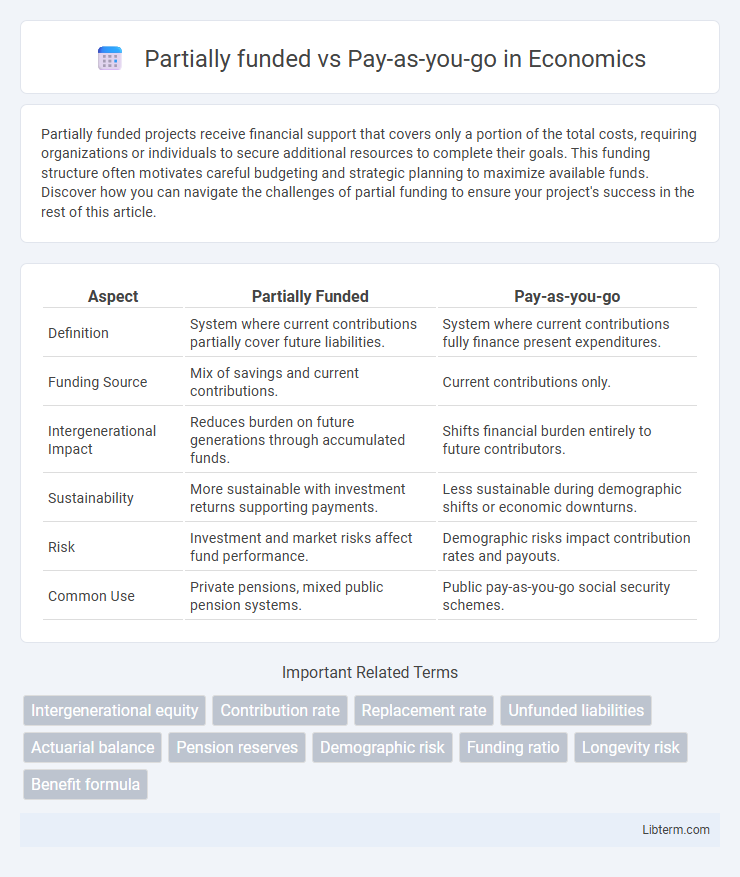Partially funded projects receive financial support that covers only a portion of the total costs, requiring organizations or individuals to secure additional resources to complete their goals. This funding structure often motivates careful budgeting and strategic planning to maximize available funds. Discover how you can navigate the challenges of partial funding to ensure your project's success in the rest of this article.
Table of Comparison
| Aspect | Partially Funded | Pay-as-you-go |
|---|---|---|
| Definition | System where current contributions partially cover future liabilities. | System where current contributions fully finance present expenditures. |
| Funding Source | Mix of savings and current contributions. | Current contributions only. |
| Intergenerational Impact | Reduces burden on future generations through accumulated funds. | Shifts financial burden entirely to future contributors. |
| Sustainability | More sustainable with investment returns supporting payments. | Less sustainable during demographic shifts or economic downturns. |
| Risk | Investment and market risks affect fund performance. | Demographic risks impact contribution rates and payouts. |
| Common Use | Private pensions, mixed public pension systems. | Public pay-as-you-go social security schemes. |
Understanding Partially Funded and Pay-as-you-go Systems
Partially funded systems use a combination of current contributions and investment returns to meet future obligations, allowing for financial sustainability over time. Pay-as-you-go systems rely on current contributions to directly pay present benefits, often creating funding gaps if demographic shifts occur. Understanding these differences is crucial for evaluating pension plan stability and long-term fiscal health.
Key Differences Between Partially Funded and Pay-as-you-go
Partially funded pension plans maintain a reserve of assets to cover future liabilities, reducing financial risks for employers and ensuring greater benefit security for participants, while pay-as-you-go plans rely on current contributions to fund immediate benefits without accumulating reserves. The key difference lies in funding strategy: partially funded plans accumulate assets over time, whereas pay-as-you-go systems depend on continuous inflows matching outflows. This distinction impacts the sustainability, risk exposure, and long-term financial planning of retirement systems.
How Partially Funded Systems Work
Partially funded systems operate by collecting employee and employer contributions to build a reserve that finances future retirement benefits, balancing current income with long-term obligations. These systems invest funds to generate returns that help cover liabilities as retirees draw benefits, reducing reliance on future contributions. By maintaining a funding ratio that reflects the system's financial health, partially funded plans provide more stability compared to pure pay-as-you-go models.
The Mechanics of Pay-as-you-go Approaches
Pay-as-you-go approaches operate by matching current contributions with current obligations, where funds are collected continuously to cover ongoing liabilities without accumulating reserves, contrasting with partially funded plans that build assets over time. This method relies heavily on real-time cash flows from active participants, often seen in social security and pension systems, enabling immediate benefit disbursement based on present income. The mechanics hinge on demographic factors, such as the ratio of contributors to beneficiaries, which directly influence sustainability and funding adequacy.
Financial Sustainability: Comparing Both Models
Partially funded pension plans invest contributions to cover a portion of future liabilities, enhancing long-term financial sustainability by building reserves that can buffer economic fluctuations. Pay-as-you-go systems rely on current contributions to pay current beneficiaries, risking fiscal instability as demographic shifts lead to funding gaps. Evaluating these models requires analyzing demographic trends, contribution rates, and investment returns to determine which approach better maintains solvency and intergenerational equity.
Advantages of Partially Funded Schemes
Partially funded schemes offer the advantage of providing a stable financial base by accumulating reserves that help ensure long-term sustainability and reduce the risk of underfunding. They combine employer and employee contributions, which allows for predictable benefit payments and improved actuarial management compared to pay-as-you-go systems. This approach helps mitigate the impact of demographic shifts and economic fluctuations on pension liabilities.
Benefits and Challenges of Pay-as-you-go Systems
Pay-as-you-go systems offer the benefit of flexibility, allowing users to pay based on actual usage, which can lead to improved cash flow management and reduced upfront costs. Challenges include potential unpredictability in budgeting due to variable monthly expenses and the risk of higher long-term costs compared to partially funded plans. These systems also require careful monitoring to avoid unexpected spikes in usage charges.
Real-world Examples: Implementation Across Countries
Partially funded pension systems are evident in countries like Canada and Australia, where a mix of funded contributions and pay-as-you-go (PAYG) schemes coexist to balance sustainability and adequacy. Germany and France primarily utilize PAYG systems that rely on current workers' contributions to finance retirees' benefits, highlighting challenges in aging populations but maintaining strong social solidarity. Sweden's notional defined contribution (NDC) system blends features of both models, using a PAYG structure with individual accounts to improve transparency and intergenerational equity.
Risks and Vulnerabilities: Economic Impact
Partially funded pension plans face the risk of underfunding due to market volatility, potentially leading to increased liabilities and taxpayer burdens. Pay-as-you-go systems are vulnerable to demographic shifts like aging populations, which strain fiscal sustainability by increasing benefit payments without proportional contributions. Both frameworks can exacerbate economic instability if unaddressed funding gaps cause sudden fiscal adjustments or reduced social spending.
Choosing the Right Model: Factors to Consider
Choosing the right pension model depends on factors such as funding stability, cash flow management, and risk tolerance. Partially funded plans require upfront capital and offer predictable benefit payments, while pay-as-you-go schemes rely on current contributions, making them sensitive to demographic shifts. Evaluating workforce age distribution, fiscal capacity, and long-term sustainability ensures alignment with organizational goals and financial realities.
Partially funded Infographic

 libterm.com
libterm.com